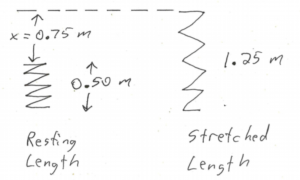Characteristics of Energy
- There are different types of energy
- Energy can be converted from one type to another
- Energy can be transferred from one object to another
- Energy cannot be created or destroyed (Energy is conserved)
- The total amount of energy in a closed system doesn’t change (“closed ” means energy is not entering or leaving the system)
What can Energy Do?
Having energy provides the potential to make many types of things happen:
- Cause a mass to accelerate (change its motion)
- Move an object upward in a gravitational field
- Cause electrical charges to move (electricity)
- Cause chemical reactions (explosions, burning, corrosion, etc)
- Cause matter to heat up or melt or boil
- Compress or stretch a spring
Law of Conservation of Energy
- Energy cannot be created or destroyed
- Energy can be transformed to other types of energy
- Total energy before equals total energy after
Types of Energy
Ek = Kinetic energy; energy of motion
Eg = Gravitational potential energy; energy stored by increasing an object’s height
Es = Spring potential energy; energy stored by stretching or compressing a spring
Echem = Chemical potential energy; energy stored in chemical bonds
Ediss = Dissipated energy; energy that becomes unavailable, often because it is converted to heat due to friction
Metric Energy Units
Joules (J)
![]()
Kinetic Energy
![]()
m = mass (kg)
v = velocity (m/s)
Gravitational Potential Energy
![]()
m = mass(kg)
g = acceleration due to gravity = 9.8 m/s2
(or round it off to g = 10 m/s2)
h = height (m)
(h = height above “zero height”; the location of zero height is defined by the human solving the problem, and typically it’s easiest if you decide that the floor or the ground is where height equals zero)
Spring Potential Energy
![]()
k = spring constant (N/m or J/m2)
(Spring constant units are setup to work nicely when energy is in Joules, mass is in kilograms, and length is in meters)
x = distance stretched or compressed (m)
(x = stretched length – resting length)
(x is how much the length of the spring has changed, not the total length of the spring)
